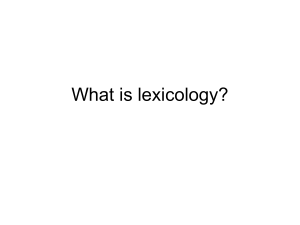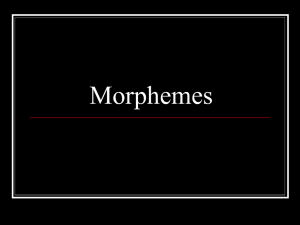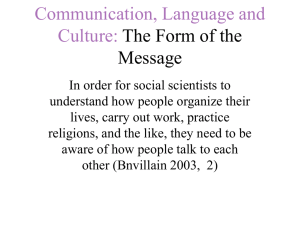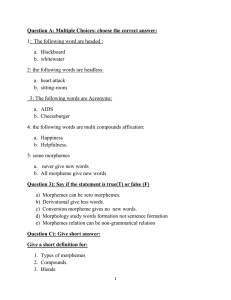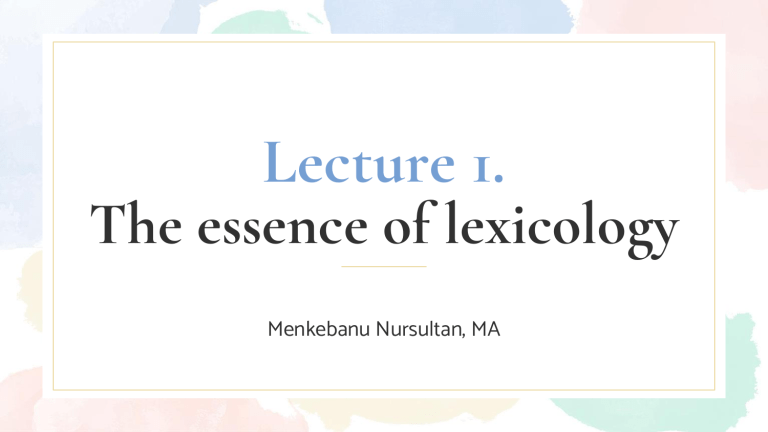
Lecture 1. The essence of lexicology Menkebanu Nursultan, MA Resources Jackson, H., & Amvela, E. Z. (2007). Words, meaning and vocabulary: An introduction to modern English lexicology. Bloomsbury Publishing. (Chapter 1, pages 2-10) What is lexicology? Lexicology may be defined as the study of lexis, understood as the stock of words in a given language, i.e. its vocabulary or lexicon (from Greek lexis, ‘word’, lexikos, ‘of/for words’). This working definition shows that the notion of ‘word’ is central in the study of lexicology. Vocabulary, lexis, and lexicon A comparison of the words ‘vocabulary’, ‘lexis’, and ‘lexicon’ would show that the three items may be considered more or less synonymous. However, it must be added that the first is more colloquial, the third more learned and technical, and the second may be situated halfway between the other two. Vocabulary, lexis, and lexicon VS Dictionary A distinction must, nevertheless, be drawn between the terms ‘vocabulary’, ‘lexis’ and ‘lexicon’ on the one hand, and ‘dictionary’ on the other. While each of the first three may refer to the total word stock of the language, a dictionary is only a selective recording of that word stock at a given point in time. Related fields Lexicology deals not only with simple words in all their aspects but also with complex and compound words, the meaningful units of language. Since these units must be analyzed in respect of both their form and their meaning, lexicology relies on information derived from morphology and semantics. A third field of particular interest in lexicological studies is etymology. However, lexicology must not be confused with lexicography, the writing or compilation of dictionaries, which is a special technique rather than a level of language study. Morphology What is morphology? Morphology is the study of morphemes and their arrangements in forming words. Morphemes are the smallest meaningful units that may constitute words or parts of words. They are ‘smallest’ or ‘minimal’ in the sense that they cannot be broken down further on the basis of meaning, as Katamba (1994: 32) puts it: ‘morphemes are the atoms with which words are built’. They are ‘meaningful’ because we can specify the kind of relationship they have with the non-linguistic world. Consider the following items cat, child, with, sleeping, armchairs, farmer Morphemes Morphemes that can occur alone as individual words are ‘free’ morphemes. Those that can occur only with another morpheme are ‘bound’ morphemes. Thus, the morphemes ‘cat’, ‘chair’, ‘farm’ are free, while ‘-ing’, ‘-s’, and ‘er’ are bound, indicated by the hyphen (-). Any concrete realization of a morpheme in a given utterance is called a ‘morph’. Hence, the forms cat, chair, farm, -ing, -s, and -er are all morphs. Morphs VS Syllables Morphs should not be confused with syllables. The basic difference between the two is that while morphs are manifestations of morphemes and represent a specific meaning, syllables are parts of words which are isolated only on the basis of pronunciation. Allomorphs An examination of a number of morphs may show that two or more morphs may vary slightly and still have the same meaning. For example, the indefinite article may be realized either as a or as an, depending on the sound (not the letter) at the beginning of the following word. Morphs which are different representations of the same morpheme are referred to as ‘allomorphs’ of that morpheme (from Greek allo ‘other’ and morph ‘form’). Semantics What is semantics? Semantics is generally defined as the study of meaning. Its aim is therefore to explain and describe meaning in natural languages. Kinds of semantics Pragmatic semantics studies the meaning of utterances in context; Sentence semantics handles the meaning of sentences as well as meaning relations between sentences; Lexical semantics deals with the meaning of words and the meaning relations that are internal to the vocabulary of a language. Philosophical VS Linguistic semantics Semantics is usually approached from one of two perspectives: philosophical or linguistic. Philosophical semantics is concerned with the logical properties of language, the nature of formal theories, and the language of logic. Linguistic semantics involves all aspects of meaning in natural languages, from the meaning of complex utterances in specific contexts to that of individual sounds in syllables. ‘Acceptability’ and ‘Meaningfulness’ ‘Acceptability’ and ‘meaningfulness’ are distinct but related concepts. They are important in our discussion of lexicology because we may have utterances that are meaningless but acceptable, while others may be meaningful but unacceptable. Consider the following That woman is a man. Consider the following That walking stick is a gun. Meaningless but acceptable They may be considered meaningless in the sense that a human being cannot be both ‘a woman’ and ‘a man’ at the same time. But with a bit of imagination, one can think of contexts where such utterances can be considered acceptable. For example, in a play, a character may be a man biologically and play the role of a woman. Consider the following Crocodiles can fly. Consider the following The basket ate the vegetables. Meaningful but unacceptable This category includes assertions that are false because of our knowledge of the real world, rather than for purely semantic reasons. Etymology What is etymology? A third field which should be of particular interest in lexicological studies is etymology, which may be defined as the study of the whole history of words, not just of their origin. Difficulties faced by etymology One of the difficulties faced by etymological studies is that some words are not etymologically related to ancient forms. It is therefore difficult to establish and indicate their origins. Consequently, the forms from which such words are said to derive can only be produced by analogy. Difficulties faced by etymology Another difficulty is that while it is possible to specify the exact time when some terms entered the language, for example through borrowing, it is clearly impossible to say exactly when a form was dropped, especially since words can disappear from use for various reasons. The most crucial difficulty The most crucial difficulty faced with etymological studies is that there can be no ‘true’ or ‘original’ meaning, since human language stretches too far back in history. Example From the etymological point of view the adjective nice really means ‘precise’ as in ‘a nice distinction’. But a study of its history shows that the word once meant ‘silly’ (Latin nescius, ‘ignorant’), and earlier, it must have been related to ne, ‘not’ and se, probably meaning ‘cut’. But at this level of analysis, one would still be left with the Latin items ne, ‘not’ and se, ‘cut’, the origins of which are still unknown. In other words, no matter how far back one goes in history, one cannot expect to reach the beginning of time. Exercise Look up the etymology of snake. What does your dictionary say is the origin? Answer Lexicography What is lexicography? The fourth and last field which is of special interest in lexicological studies is lexicography, which has already been defined as a special technique, the writing and compilation of dictionaries. This definition may be considered rather restrictive. In its widest sense, lexicography may also refer to the principles that underlie the process of compiling and editing dictionaries. Thank you for your attention!

